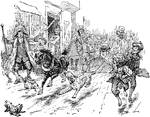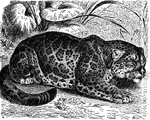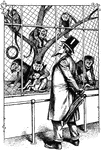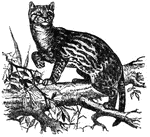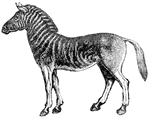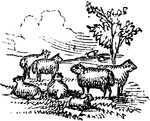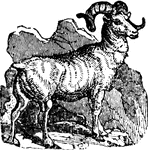
Striped Hyena
Hyenas look like dogs, but are more closely related to cats and civets. Their front legs are longer…

Ibex
Sure-footed hooved mammals found in mountainous areas. Males have heavily ridged horns that curve up…
Ichneumon
These mammals have pointed snouts and long bodies which they use to hunt prey of snakes or eggs.
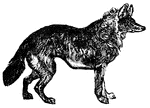
Jackal
Similar to the fox in appearance, but without the bushy tail. They are found in Africa and S. Asia.…
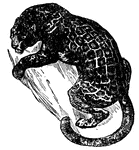
Jaguar
The jaguar can spend a great deal of time in trees, but are known to also hunt fish. They range from…
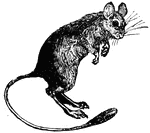
Jerboa
the jerboa have long tails with tufted ends, and long hind legs, which enable them to make enormous…

Kangaroo
Kangaroos are found in Australia, New Guinea and Tasmania. They have powerful rear legs and a muscular…
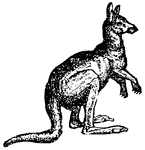
Kangaroo
Kangaroos are found in Australia, New Guinea and Tasmania. They have powerful rear legs and a muscular…

Kangaroo Pelvis
An illustration of a kangaroo pelvis. "M, marsupial bones, borne upon P, pubis; Il, ilium; Is, ischium;…

Kinkajou
The kinkajou lives in S. America and spends most of its life in trees. It hunts at night for insects…
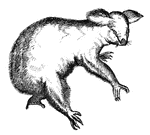
Koala
Koalas are marsupials, which means the females have a pouch of skin into which the very immature young…

Kudu
A native of S. Africa and similar in appearance to the antelope. The male's horns are nearly five feet…

Lemur
The lemur (Latin, lemures, ghosts) get their name from the fact that their movements are noiseless,…

Chimp Limb
The forelimb of chimpanzee. (c) collar bone; (s) shoulder blade; (h) humerus; (r) radius; (u) ulna;…
Chimp Limb
The hindlimb of chimpanzee. (i) innominate bone; (f) thigh bone; (t) tibia; (s) fibula; (r) bones of…
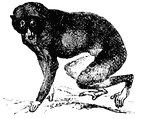
Loris
The loris is found in India. It is skillful in capturing birds, which it does in the night when they…
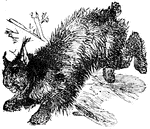
Canada Lynx
The Canada lynx is remarkable for its gait, going by successive leaps with the back arched. Its diet…

Manatee
the manatee, an aquatic mammal, is found along both shores of the Atlantic in tropical regions and in…

Mandrill
The mandrill is known for its various and brilliant coloration. Its coat is olive brown and it has a…

Pine Marten
The pine marten lives most of its life in trees, but does hunt on the ground. It feeds primarily on…

Mole
The eyes of the mole are very small, but its hearing and smell are acute. Its fur is fine and soft,…

Mole
Moles are well fitted for digging by the very large front feet and strong muscles of the front legs.…
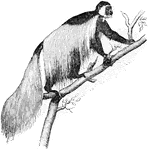
Colobus Monkey
Monkey, a word loosely applied to apes, baboons, Old and New World monkeys, marmosets and lemurs.

Hanaman Monkey
Monkey, a word loosely applied to apes, baboons, Old and New World monkeys, marmosets and lemurs.
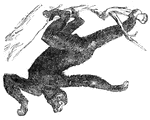
Spider Monkey
The spider monkey uses its tail in climbing. It uses its tail also to feel with, and to seize small…

Spider Monkey
Monkey, a word loosely applied to apes, baboons, Old and New World monkeys, marmosets and lemurs.
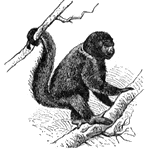
Wooly Monkey
Monkey, a word loosely applied to apes, baboons, Old and New World monkeys, marmosets and lemurs.

Capuchin Monkey
Monkey, a word loosely applied to apes, baboons, Old and New World monkeys, marmosets and lemurs.
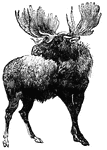
Moose
One of the largest species of hooved mammals in the deer family. Known as the moose in North America,…
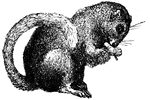
Dormouse
When a dormouse holds a nut to make a hole in it, he holds it between his two forepaws like hands.

Mammals from the Oligocene Mammals
Mammals from the Oligocene age. Shown are the Titanothere, Entelodont, Hyracodon, Uintathere, and the…
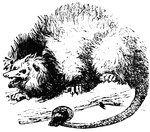
Opossum
The opossum is nocturnal and arboreal. At night it searches for insects, birds, eggs, fruit, etc. It…
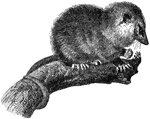
Opossum
"Opossum, of the marsupial family. Some species have pouches while others do not, and will therefore…
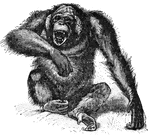
Orangutan
"Monkey, a word loosely applied to apes, baboons, Old and New World monkeys, marmosets and lemurs."—…

Organic Life, Collage of
A collage of different types of organic life including deer in a forest, farmers harvesting wheat, and…

Oryx
The oryx is a native of S. Africa. It is one of the fastest animals in that region. It is similar in…

Musk Ox
Musk Ox or Musk Sheep, an animal combining characteristics of the ox and sheep; in size and shape resembling…

Pangolin
This is a type of anteater, covered in an armor of horny scales. When attacked, they roll themselves…

Platypus
The platypus is an interesting mammal, which inhabits the rivers and lakes of Australia and Tasmania.
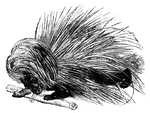
Porcupine
The porcupine is covered in spikes or quills that are its chief defense. If it can't escape, it stands…

Raccoon
Raccoon, a tree-climbing, nocturnal animal belonging to the bear family and restricted to North and…
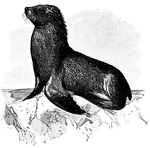
Sea Lion
Otaria jubata. One of several large eared seals, or otaries. Also called "Cook's otary" or the "Patagonian…

Seal
The seal is an aquatic mammal, whose limbs are formed into flippers. The tail tapers at the end of the…
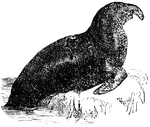
Elephant seal
The elephant seal is the largest fin-footed mammal. It can reach 18 feet in length and weigh 5000 pounds.…
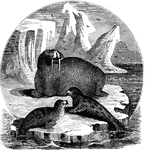
Seals and Walrus
Fur Seals make up one of the two distinct groups of mammals called "seals". Both the fur seals and the…

Shrew
Shrews are among the smallest mammals. They have long snouts that they use in grubbing the earth in…
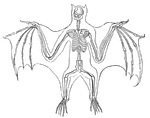
Bat Skeleton
In the bat, the forelimbs are much longer than the hindlimbs and have several of the fingers greatly…
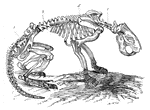
Beaver Skeleton
The skeleton of a beaver.(c) cervical region of vertebral column; (d) dorsal region; (b) lumbar region;…

